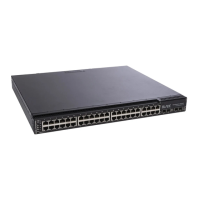280 RackSwitch G8000: Application Guide
OSPFv3 Identifies Neighbors by Router ID
Where OSPFv2 uses a mix of IPv4 interface addresses and Router IDs to identify
neighbors, depending on their type, OSPFv3 configuration consistently uses a
Router ID to identify all neighbors.
Although Router IDs are written in dotted decimal notation, and may even be based
on IPv4 addresses from an original OSPFv2 network configuration, it is important to
realize that Router IDs are not IP addresses in OSPFv3, and can be assigned
independently of IP address space. However, maintaining Router IDs consistent
with any legacy OSPFv2 IPv4 addressing allows for easier implementation of both
protocols.
Other Internal Improvements
OSPFv3 has numerous improvements that increase the protocol efficiency in
addition to supporting IPv6 addressing. These improvements change some of the
behaviors in the OSPFv3 network and may affect topology consideration, but have
little direct impact on configuration. For example:
•
Addressing fields have been removed from Router and Network LSAs.
•
Link-local flooding scope has been added, along with a Link LSA. This allows
flooding information to relevant local neighbors without forwarded it beyond the
local router.
•
Flexible treatment of unknown LSA types to make integration of OSPFv3 easier.
OSPFv3 Limitations
N/OS 6.8 does not currently support the following OSPFv3 features:
•
Multiple instances of OSPFv3 on one IPv6 link.
•
Authentication via IPv6 Security (IPsec)
OSPFv3 Configuration Example
The following example depicts the OSPFv3 equivalent configuration of “Example 3:
Summarizing Routes” on page 277 for OSPFv2.
In this example, one summary route from area 1 (stub area) is injected into area 0
(the backbone). The summary route consists of all IP addresses from the 36::0/32
portion of the 36::0/56 network, except for the routes in the 36::0/8 range.
Figure 33. Summarizing Routes
Note: You can specify a range of addresses to prevent advertising by using the
hide option. In this example, routes in the 36::0/8 range are kept private.
IF 3
10::1
IF 4
36::1
10::0/56
Network
36::0/56
Network
36::0/32
(- 36::0/8)
Backbone
Stub Area
Summary Route
ABR
Area 0
(0.0.0.0)
Area 1
(0.0.0.1)

